
C5
.pdf
A R C H I T E C T U R A L B A S I C S
Greek Temple Plans
The core of an ancient Greek temple plan (FIG. 5-13) was the naos, or cella, a room with no windows that usually housed the cult statue of the deity. It was preceded by a pronaos, or porch, often with two columns between the antae, or extended walls (columns in antis). A smaller second room might be placed behind the cella (FIG. 5-16), but in its canonical form, the Greek temple had a porch at the rear (opisthodomos) set against the blank back wall of the cella. The purpose was not functional but decorative, satisfying the Greek passion for balance and symmetry. A colonnade could be placed across the front of the temple (prostyle; FIG. 5-52), across both front and back (amphiprostyle; FIG. 5-55), or, more commonly, all around the cella and its porch(es) to form a peristyle, as in FIG. 5-13 (compare FIG. 5-15). Single (peripteral) colonnades were the norm, but double (dipteral) colon-
nades were features of especially elaborate temples (FIG. 5-75).
Anta |
Stylobate (level on which columns stand) |
|
|
Columnsin antis |
|
||
Opisthodomos |
Cella (Naos) |
Pronaos |
|
|
|
|
|
Anta |
Peristyle (external colonnade on all four sides) |
||
5-13 Plan of a typical Greek peripteral temple.
The basic form of the canonical Greek temple derives from that of the megaron of a Mycenaean palace (FIG. 4-18), but Greek temples housed statues of deities and most were surrounded by columns.
sculptors delighted in rendering the intricate patterns created by the cascading folds of thin, soft material. In another Acropolis kore (FIG. 5-12), the asymmetry of the folds greatly relieves the stiff frontality of the body and makes the figure appear much more lifelike than contemporary kouroi. The sculptor achieved added variety by showing the kore grasping part of her chiton in her left hand (unfortunately broken off) to lift it off the ground in order to take a step forward. This is the equivalent of the advanced left foot of the kouroi and became standard for statues of korai. Despite the varied surface treatment of brightly colored garments on the korai, the kore postures are as fixed as those of their male counterparts.
Architecture and Architectural Sculpture
Many of the earliest Greek temples do not survive because they were built of wood and mud brick. Pausanias noted in his second-century CE guidebook to Greece that in the even-then-ancient Temple of Hera at Olympia, one oak column was still in place. (Stone columns had replaced the others.) Archaic and later Greek temples, however, were constructed of more permanent materials—limestone, in many cases, and, where it was available, marble, which was more impressive and durable (and more expensive). In Greece proper, if not in its western colonies, marble was readily at hand. Bluish-white marble came from Hymettus, just east of Athens. Glittering white marble particularly adapted for carving was brought from Pentelicus, northeast of the city, and from the Aegean Islands, especially Paros.
Already in the Orientalizing seventh century BCE, the Greeks had built at Prinias a stone temple (FIG. 5-6) embellished with stone sculptures, but the Cretan temple resembled the megaron of a Mycenaean palace more than anything Greek traders had seen in their travels overseas. In the Archaic age of the sixth century, with the model of Egyptian columnar halls such as that at Karnak (FIG. 3-25) before them, Greek architects began to build the columnar stone temples that became more influential on the later history of architecture in the Western world than any other building type ever devised.
Greek temples differed in function from most later religious shrines. The altar lay outside the temple—at the east end, facing the rising sun—and the Greeks gathered outside, not inside, the building to worship. The temple proper housed the so-called cult statue of
the deity, the grandest of all votive offerings. Both in its early and mature manifestations, the Greek temple was the house of the god or goddess, not of his or her followers.
TEMPLE PLANS In basic plan (see “Greek Temple Plans,” above, and FIG. 5-13), the Greek temple still discloses a close affinity with the Mycenaean megaron (FIG. 4-18), and, even in its most elaborate form, it retains the latter structure’s basic simplicity. In all cases, the remarkable order, compactness, and symmetry of the Greek scheme strike the eye first, reflecting the Greeks’ sense of proportion and their effort to achieve ideal forms in terms of regular numerical relationships and geometric rules. Whether the plan is simple or more complex, no fundamental change occurs in the nature of the units or of their grouping. Classical Greek architecture, like classical music, has a simple core theme with a series of complex, but always quite intelligible, variations developed from it.
The Greeks’ insistence on proportional order guided their experiments with the proportions of temple plans. The earliest temples tended to be long and narrow, with the proportion of the ends to the sides roughly expressible as 1:3. From the sixth century BCE on, plans approached but rarely had a proportion of exactly 1:2. Classical temples tended to be a little longer than twice their width. To the Greek mind, proportion in architecture and sculpture was much the same as harmony in music, reflecting and embodying the cosmic order.
TEMPLE ORNAMENTATION Figural sculpture played a major role in the exterior program of the Greek temple from early times, partly to embellish the god’s shrine, partly to tell something about the deity symbolized within, and partly to serve as a votive offering. But the building itself, with its finely carved capitals and moldings, also was conceived as sculpture, abstract in form and possessing the power of sculpture to evoke human responses. The commanding importance of the sculptured temple, its inspiring function in public life, was emphasized in its elevated site, often on a hill above the city (acropolis means “high city”).
Sculptural ornament was concentrated on the upper part of the building, in the frieze and pediments (see “Doric and Ionic Orders,” page 96). Architectural sculpture, like freestanding statuary, was painted (FIG. 5-27, right) and usually was placed only in the building parts that had no structural function. This is true particularly of the
Archaic Per iod |
95 |

A R C H I T E C T U R A L B A S I C S
Doric and Ionic Orders
Architectural historians describe the elevation (FIG. 5-14) of a Greek temple in terms of the platform, the colonnade, and the superstructure (entablature). In the Archaic period, two basic systems evolved for articulating the three units. These are the so-called orders of Greek architecture. The orders are differentiated both in the nature of the details and in the relative proportions of the parts. The names of the orders derive from the Greek regions where they were most commonly employed. The Doric, formulated on the mainland, remained the preferred manner there and in the western colonies of the Greeks. The Ionic was the order of choice in the Aegean Islands and on the western coast of Asia Minor. The geographical distinctions are by no means absolute. The Ionic order, for example, was often used in Athens (where, according to some, the
Athenians considered themselves Ionians who never migrated).
In both orders, the columns rest on the stylobate, the uppermost course of the platform. Metal clamps held together the stone blocks in each horizontal course, and metal dowels joined vertically the blocks of different courses. The columns have two or three parts, depending on the order: the shaft, which is marked with vertical channels (flutes); the capital; and, in the Ionic order, the base. Greek column shafts, in contrast to their Minoan and Mycenaean forebears, taper gradually from bottom to top. They usually are composed of separate drums
joined by metal dowels to prevent turning as well as shifting, although instances of monolithic (single-piece) columns are known. The capital has two elements. The lower part (the echinus) varies with the order. In the Doric, it is convex and cushionlike, similar to the echinus of Minoan (FIG. 4-6) and Mycenaean (FIG. 4-1) capitals. In the Ionic, it is small and supports a bolster ending in scroll-like spirals (the volutes). The upper element, present in both orders, is a flat, square block (the abacus) that provides the immediate support for the entablature.
The entablature has three parts: the architrave, the main weightbearing and weight-distributing element; the frieze; and the cornice, a molded horizontal projection that together with two sloping (raking) cornices forms a triangle that enframes the pediment. In the Ionic order, the architrave is usually subdivided into three horizontal bands. In the Doric order, the frieze is subdivided into triglyphs and metopes, whereas in the Ionic the frieze is left open to provide a continuous field for relief sculpture.
The Doric order is massive in appearance, its sturdy columns firmly planted on the stylobate. Compared with the weighty and severe Doric, the Ionic order seems light, airy, and much more decorative. Its columns are more slender and rise from molded bases. The most obvious differences between the two orders are, of course, in the capitals—the Doric, severely plain, and the Ionic, highly ornamental.
5-14 Elevations of the Doric and Ionic orders.
The major differences between the Doric and Ionic orders are the form of the capitals and the treatment of the frieze. The Doric frieze is divided into triglyphs and metopes.
96 Chapter 5 A N C I E N T G R E E C E
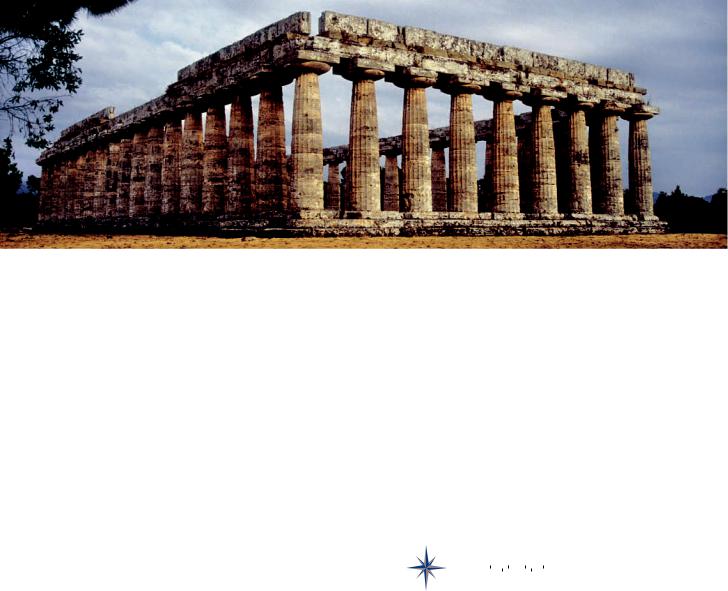
5-15 Temple of Hera I (“Basilica”), Paestum, Italy, ca. 550 BCE.
The peristyle of this huge early Doric temple consists of heavy, closely spaced, cigar-shaped columns with bulky, pancakelike capitals, characteristic features of Archaic Greek architecture.
Doric order (FIG. 5-14, left), where decorative sculpture appears only in the metope and pediment “voids.” Ionic (FIG. 5-14, right) builders, less severe in this respect as well, were willing to decorate the entire frieze and sometimes even the lower column drums. Occasionally, they replaced their columns with female figures (caryatids; FIGS. 5-18 and 5-54). Capitals, decorative moldings, and other architectural elements were also painted. By painting parts of the building, the designer could bring out more clearly the relationships of the structural parts and soften the stone’s glitter at specific points, as well as provide a background to set off the figures.
Although the Greeks used color for emphasis and to relieve what might have seemed too bare a simplicity, Greek architecture primarily depended on clarity and balance. To the Greeks, it was unthinkable to use surfaces in the way the Egyptians used their gigantic columns—as fields for complicated ornamentation (FIG. 3-25). The history of Greek temple architecture is the history of Greek architects’ unflagging efforts to find the most satisfactory (that is, what they believed were perfect) proportions for each part of the building and for the structure as a whole.
BASILICA, PAESTUM The prime example of early Greek efforts at Doric temple design is not in Greece but in Italy, south of Naples, at Paestum (Greek Poseidonia). The huge (80 170 feet) Archaic temple (FIG. 5-15) erected there around 550 BCE retains its entire peripteral colonnade, but most of the entablature, including the frieze, pediment, and all of the roof, has vanished. Called the “Basilica” after the Roman columnar hall building type (see Chapter 10) that early investigators felt it resembled, the structure was actually a temple of Hera. Scholars refer to it as the Temple of Hera I to distinguish it from its later neighbor, the Temple of Hera II (FIG. 5-30). The misnomer is partly due to the building’s plan (FIG. 5-16), which differs from that of most other Greek temples. The unusual feature, found only in early Archaic temples, is the central row of columns that divides the cella into two aisles. Placing columns underneath the ridgepole (the timber beam running the length of the building below the peak of the gabled roof) might seem the logical way to provide interior support for the roof structure, but it resulted in several disadvantages. Among these was that this interior arrangement allowed no place for a central statue of the deity to whom the temple was
1
2
N
0 |
10 20 |
30 40 |
50 |
feet |
1. |
Cella with central |
||||||
|
row of columns |
|||||||||||
|
|
|
|
|
|
|
|
|
|
|
2. |
Pronaos with three |
|
|
|
|
|
|
|
|
|
|
|
||
0 |
5 |
|
10 |
|
15 meters |
|||||||
|
|
|
|
|||||||||
columns in antis
5-16 Plan of the Temple of Hera I, Paestum, Italy, ca. 550 BCE.
The Hera temple’s plan also reveals its early date. The temple has an odd number of columns on the facade and a single row of columns in the cella, leaving no place for a central cult statue.
dedicated. Also, the peripteral colonnade, in order to correspond with the interior, required an odd number of columns (nine in this case) across the building’s facade. At Paestum, the builders also set three columns in antis instead of the standard two, which in turn ruled out a central doorway for viewing the statue. (Some scholars have suggested, however, that this design was well suited for two statues, perhaps of Zeus and Hera.) The architect nonetheless achieved a simple 1:2 ratio of facade and flank columns by erecting 18 columns on each side of the temple.
Another early aspect of the Paestum temple is the shape of its heavy, closely spaced columns (FIG. 5-15) with their large, bulky, pancakelike Doric capitals, which seem compressed by the overbearing weight of the entablature. The columns have a pronounced swelling (entasis) at the middle of the shafts, giving them a profile akin to that of a cigar. If the temple’s immense roof were preserved, the columns would seem even more compressed, squatting beneath
Archaic Per iod |
97 |

1 ft.
5-17 West pediment from the Temple of Artemis, Corfu, Greece, ca. 600–580 BCE. Limestone, greatest height 9 4 . Archaeological Museum, Corfu.
The hideous Medusa and two panthers at the center of this early pediment serve as temple guardians. To either side, and much smaller, are scenes from the Trojan War and the battle of gods and giants.
what must have been a high and massive entablature. The columns and capitals thus express in a vivid manner their weight-bearing function. One structural reason, perhaps, for the heaviness of the design and the narrowness of the spans between the columns might be that the Archaic builders were afraid thinner and more widely spaced columns would result in the superstructure’s collapse. In later Doric temples (FIGS. 5-25, 5-30, and 5-44), the builders placed the columns farther apart and refined the forms. The shafts became more slender, the entasis subtler, the capitals smaller, and the entablature lighter. Greek architects sought the ideal proportional relationship among the parts of their buildings. The sculptors of Archaic kouroi and korai grappled with similar problems. Architecture and sculpture developed in a parallel manner in the sixth century BCE.
TEMPLE OF ARTEMIS, CORFU Architects and sculptors were also frequently called on to work together, as at Corfu (ancient Corcyra), where the Greeks constructed a great Doric temple dedicated to Artemis in the sixth century BCE. Corfu, an island off the western coast of Greece, was an important stop on the trade route between the mainland and the Greek settlements in Italy (MAP 5-1). Prosperity made possible the erection of one of the earliest stone peripteral temples in Greece, one also lavishly embellished with sculpture. Reliefs (unfortunately very fragmentary today) decorated the metopes, and huge high-relief sculptures (more than nine feet high at the center) filled both pediments. The pediments appear to have been decorated in an identical manner. The west pediment (FIG. 5-17) is better preserved.
Designing figural decoration for a pediment was never an easy task for the Greek sculptor because of the pediment’s awkward triangular shape. The central figures had to be of great size. In contrast, as the pediment tapered toward the corners, the available area became increasingly cramped. At the center of the Corfu pediment is the gorgon Medusa, a demon with a woman’s body and a bird’s wings. Medusa also had a hideous face and snake hair, and anyone who gazed at her turned into stone. The sculptor depicted her in the conventional Archaic bent-leg, bent-arm, pinwheel-like posture that signifies running or, for a winged creature, flying. To her left and right are two great felines. Together they serve as temple guardians, repulsing all enemies from the sanctuary of the goddess. Similar panthers
stood sentinel on the lintel of the seventh-century BCE temple at Prinias. The Corfu felines are in the tradition of the guardian lions of the citadel gate (FIG. 4-1) at Mycenae and the beasts that stood guard at the entrances to Near Eastern palaces (FIGS. 2-18 and 2-21). The triad of Medusa and the felines recalls as well Mesopotamian heraldic human-and-animal compositions (FIG. 2-10). The Corfu figures are, in short, still further examples of the Orientalizing manner in early Greek sculpture.
Between Medusa and the two felines are two smaller figures— the human Chrysaor at her left and the winged horse Pegasus at her right (only the rear legs are preserved next to Medusa’s right foot). Chrysaor and Pegasus were Medusa’s children. According to legend, they sprang from her head when the Greek hero Perseus severed it with his sword. Their presence here on either side of the living Medusa is therefore a chronological impossibility. The Archaic artist had less interest in telling a coherent story than in identifying the central figure by depicting her offspring. Narration was, however, the purpose of the much smaller groups situated in the pediment corners. To the viewer’s right is Zeus, brandishing his thunderbolt and slaying a kneeling giant. In the extreme corner (not preserved) was probably a dead giant. The gigantomachy (battle of gods and giants) was a popular theme in Greek art from Archaic through Hellenistic times and was a metaphor for the triumph of reason and order over chaos. In the pediment’s left corner is one of the Trojan War’s climactic events: Achilles’ son Neoptolemos kills the enthroned King Priam. The fallen figure to the left of this group may be a dead Trojan.
The master responsible for the Corfu pediments was a pioneer, and the composition shows all the signs of experimentation. The lack of narrative unity and the figures’ extraordinary diversity of scale eventually gave way to pedimental designs with freestanding figures in place of reliefs all acting out a single event and appearing the same size. But the Corfu designer already had shown the way, by realizing, for example, that the area beneath the raking cornice could be filled with gods and heroes of similar size if a combination of standing, leaning, kneeling, seated, and prostrate figures were employed in the composition. The Corfu master also discovered that animals could be very useful space fillers because, unlike humans, they have one end taller than the other.
98 Chapter 5 A N C I E N T G R E E C E
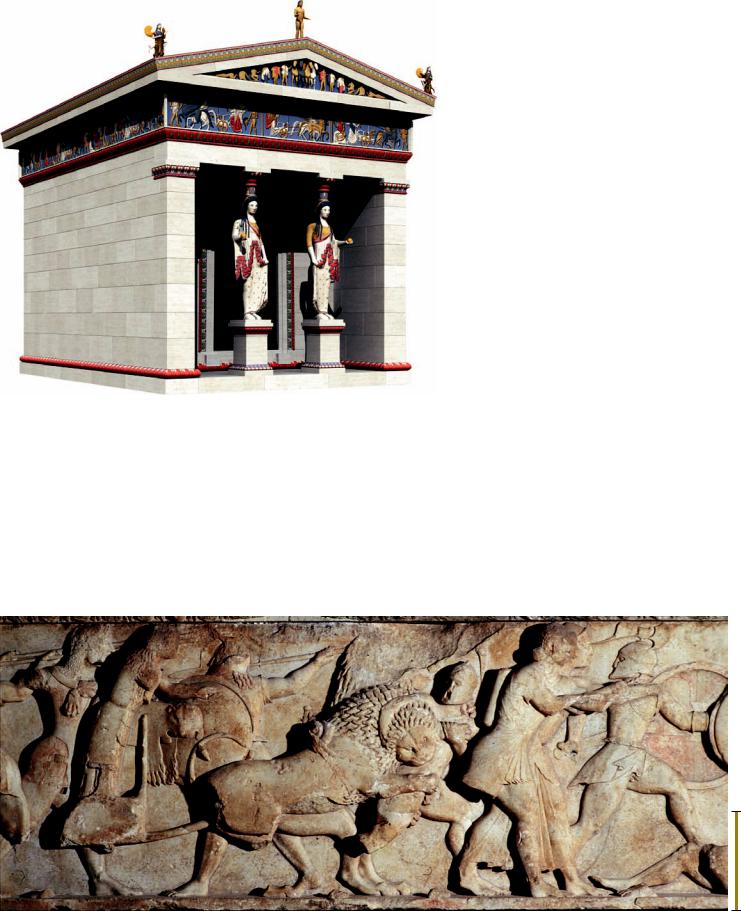
SIPHNIAN TREASURY, DELPHI The sixth century BCE also saw the erection of grandiose Ionic temples on the Aegean Islands and the west coast of Asia Minor. The gem of Archaic Ionic architecture and architectural sculpture, however, is not a temple but a treasury erected by the city of Siphnos in the Sanctuary of Apollo at Delphi. It can be reliably reconstructed (FIG. 5-18) based on the surviving fragments now on display in the Delphi museum. Greek treasuries were small buildings set up for the safe storage of votive offerings. At Delphi many poleis expressed their civic pride by erecting these templelike but nonperipteral structures. Athens built one with
5-18 Reconstruction drawing of the Siphnian Treasury, Delphi, Greece, ca. 530 BCE (John Burge).
Treasuries were storehouses in sanctuaries for a city’s votive offerings. The Ionic treasury the Siphnians erected at Delphi featured caryatids in the porch,
and sculptures in the pediment and frieze.
Doric columns in the porch and sculptured metopes in the frieze. The Siphnians equally characteristically employed the Ionic order for their Delphic treasury. Wealth from the island’s gold and silver mines made the luxurious building possible. In the porch, where one would expect to find fluted Ionic columns, far more elaborate caryatids were employed instead. Caryatids are rare, even in Ionic architecture, but they are unknown in Doric architecture, where they would have been discordant elements in that much more severe order. The Siphnian statue-columns resemble contemporary korai dressed in Ionian chitons and himations (FIG. 5-12).
Another Ionic feature of the Siphnian Treasury is the continuous sculptured frieze on all four sides of the building. The north frieze represents the
popular theme of the gigantomachy, but the rendition is much more detailed than that in the corner of the Corfu pediment. In the section reproduced here (FIG. 5-19), Apollo and Artemis pursue a fleeing giant at the right, while behind them one of the lions pulling a goddess’s chariot attacks a giant and bites into his midsection. Paint originally enlivened the crowded composition, and painted labels identified the various protagonists. Some figures had metal weapons. The effect must have been dazzling. On one of the shields the sculptor inscribed his name (unfortunately lost), a clear indication of pride in accomplishment.
1 ft.
5-19 Gigantomachy, detail of the north frieze of the Siphnian Treasury, Delphi, Greece, ca. 530 BCE. Marble, 2 1 high. Archaeological Museum,
Delphi.
Greek friezes were brightly painted. As in contemporaneous vase painting, the Siphnian frieze also had painted labels identifying the various gods and giants. Some of the figures held metal weapons.
Archaic Per iod |
99 |
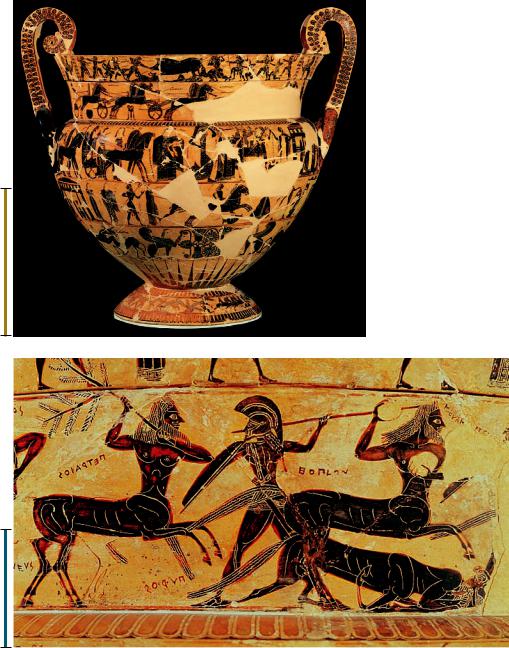
Vase Painting
Labeled figures and artists’ signatures also appear on Archaic painted vases. By the mid-sixth century BCE, the Athenians, having learned the black-figure technique from the Corinthians (FIG. 5-5), had taken over the export market for fine painted ceramics.
FRANÇOIS VASE The masterpiece of early Athenian blackfigure painting is the François Vase (FIG. 5-20), named for the excavator who uncovered it in an Etruscan tomb at Chiusi. The vase is a new kind of krater with volute-shaped handles, probably inspired by costly metal prototypes. It was signed by both its painter (“KLEITIAS painted me”) and potter (“ERGOTIMOS made me”), whose signatures each appear twice among the more than 200 figures in six registers. Labels abound, naming humans and animals alike, even some inanimate objects. The painter devoted only one of the bands to the Orientalizing repertoire of animals and sphinxes. The rest constitute a selective encyclopedia of Greek mythology, focusing on the exploits of Peleus and his son Achilles, the great hero of Homer’s Iliad, and of Theseus, the legendary king of Athens.
1 ft.
1 in.
In the detail shown here (FIG. 5-20, bottom), Lapiths (a northern Greek tribe) and centaurs battle (centauromachy) after a wedding celebration where the man-beasts, who were invited guests, got drunk and attempted to abduct the Lapith maidens and young boys. Theseus, also on the guest list, was prominent among the centaurs’ Greek adversaries. Kleitias did not fill the space between his figures with decorative ornament, as did his Geometric predecessors (FIG. 5-2). But his heroes still conform to the age-old composite type (profile heads with frontal eyes, frontal torsos, and profile legs and arms). His centaurs, however, are much more believable than their Geometric counterparts (FIG. 5-3). The man-horse combination is top/bottom rather than front/back. The lower (horse) portion has four legs of uniform type, and the upper part of the monster is fully human. In characteristic fashion, Kleitias painted the animal section of the centaur in strict profile, whereas the human head and torso are a composite of frontal and profile views. (He used a consistent profile for the more adventurous detail of the collapsed centaur at the right.)
EXEKIAS The acknowledged master of the black-figure technique was an Athenian named EXEKIAS, whose vases were not only widely exported but copied as well. Perhaps his greatest work is an amphora (FIG. 5-21), found in an Etruscan tomb at Vulci, that Exekias signed as both painter and potter. Unlike Kleitias, Exekias did not divide the surface of the vase into a series of horizontal bands. Instead, he placed figures of monumental stature in a single large framed panel. At the left is Achilles, fully armed. He plays a dice game with his comrade Ajax. From the lips of Achilles comes the word tesara (four). Ajax calls out tria (three). Although Ajax has taken off his helmet, both men hold their spears, and their shields are close at hand. Each man is ready for action at a moment’s notice. This depiction of “the calm before the storm” is the antithesis of the Archaic preference for dramatic action. The gravity and tension that will characterize much Classical Greek art of the next century, but that are absent in Archaic art, already may be seen in this vase.
Exekias had no equal as a black-figure painter. This is evident in such details as the extraordinarily intricate engraving of the patterns on the heroes’ cloaks (highlighted with delicate touches of white) and in the brilliant composition. The arch formed by the backs of the two warriors echoes the shape of the rounded shoulders of the amphora. The shape of the vessel (compare FIG. 5-22) is echoed again in the void between the heads and spears of Achilles and Ajax. Exekias also used the spears to lead the viewer’s eyes toward the thrown dice, where the heroes’ eyes are fixed. Of course, those eyes
5-20 KLEITIAS and ERGOTIMOS,
François Vase (Athenian black-figure volute krater), from Chiusi, Italy, ca. 570 BCE. General view (top) and
detail of centauromachy on other side of vase (bottom). 2 2 high. Museo
Archeologico, Florence.
Found in an Etruscan tomb, this huge krater is signed by both the painter and the potter and has more than 200 mythological figures presented in registers, as on Geometric and Orientalizing vases.
100 Chapter 5 A N C I E N T G R E E C E
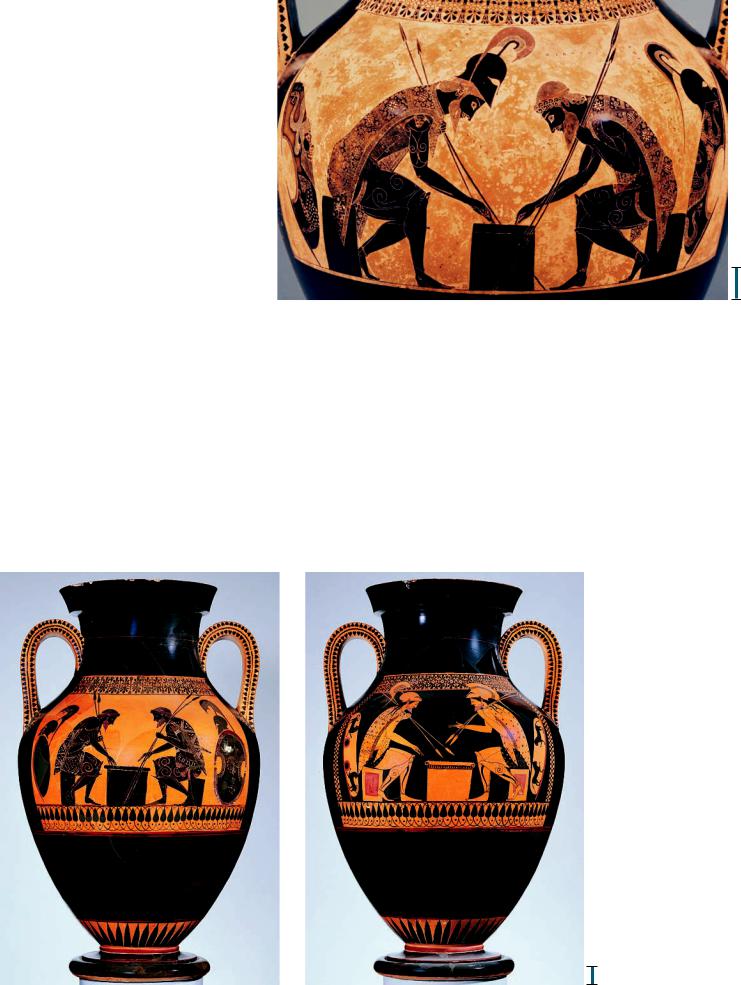
5-21 EXEKIAS, Achilles and Ajax playing a dice game (detail from an Athenian black-figure amphora), from Vulci, Italy, ca. 540–530 BCE.
Whole vessel 2 high; detail 8– high. Musei
1
2
Vaticani, Rome.
The dramatic tension, adjustment of figures’ poses to the vase’s shape, and intricacy of the engraved patterns of the cloaks are hallmarks of Exekias, the greatest master of black-figure painting.
do not really look down at the table but stare out from the profile heads in the old manner. For all his brilliance, Exekias was still wedded to many of the old conventions. True innovation in figure drawing would have to await the invention of a new ceramic painting technique of greater versatility than black-figure, with its dark silhouettes and incised details.
BILINGUAL PAINTING The birth of this new technique came around 530 BCE from an artist known as the ANDOKIDES PAINTER, that is, the anonymous painter who decorated the vases signed by the potter Andokides. The differences between the two techniques can best be studied on a series of experimental vases with the same composition painted on both sides, once in black-figure and once in the new technique, red-figure. Such vases, nicknamed bilingual vases, were produced for only a short time. An especially interesting example is an amphora (FIG. 5-22) by the Andokides Painter that features copies of the Achilles and Ajax panel by Exekias, his teacher.
In neither black-figure nor red-figure did the Andokides Painter capture the intensity of the model, and the treatment of details is decidedly inferior. Yet the new red-figure technique had obvious advantages over the old black-figure treatment. Red-figure is the opposite
1 in.
of black-figure. What was previously black became red, and vice versa. The artist employed the same black glaze but instead of using it to create the silhouettes of figures, the painter outlined the figures and then colored the background black. The artist reserved the red clay for the figures themselves. Interior details were then drawn with a soft brush in place of a stiff metal graver, giving the painter much greater flexibility. The artist could vary the thickness of the lines and even build up the glaze to give relief to curly hair or dilute it to create brown shades, thereby expanding the chromatic range of the Greek vase painter’s craft. The Andokides Painter—many think he was the potter Andokides himself—did not yet appreciate the full potential of his invention. But he created a technique that, in the hands of other, more skilled artists, helped revolutionize the art of drawing.
5-22 ANDOKIDES
PAINTER, Achilles and Ajax playing a dice game (Athenian bilingual amphora), from Orvieto, Italy,
ca. 525–520 BCE. Blackfigure side (left) and red-figure side (right). 1 9 high. Museum of
Fine Arts, Boston.
Around 530 BCE, the Andokides Painter invented the redfigure technique. Some of his early vases are “bilingual”—that is,
the same scene appears on both sides, one in black-figure and one
in red-figure.
1 in.
Archaic Per iod |
101 |
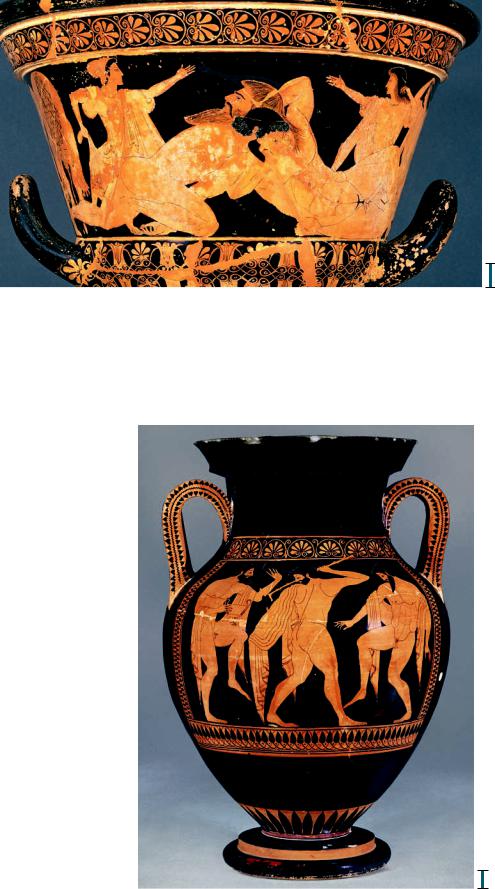
5-23 EUPHRONIOS, Herakles wrestling Antaios (detail of an Athenian red-figure calyx krater), from Cerveteri, Italy, ca. 510 BCE.
Whole vessel 1 7 high; detail 7– high.
3
4
Louvre, Paris.
Euphronios rejected the age-old composite view for his depiction of Herakles and the giant Antaios and instead attempted to reproduce how the human body is seen from a particular viewpoint.
EUPHRONIOS One of these younger and more adventurous painters was EU- PHRONIOS, whose krater depicting the struggle between Herakles and Antaios (FIG. 5-23) reveals the exciting possibili-
ties of the new red-figure technique. Antaios was a Libyan giant, a son of Earth, and he derived his power from contact with the ground. To defeat him, Herakles had to lift him into the air and strangle him while no part of the giant’s body touched the earth. In the scene on the krater, the two wrestle on the ground, and Antaios still possesses enormous strength. Nonetheless, Herakles has the upper hand. The giant’s face is a mask of pain. His eyes roll and his teeth are bared. His right arm is paralyzed, with the fingers limp.
Euphronios used diluted glaze to show Antaios’s unkempt golden brown hair—intentionally contrasted with the neat coiffure and carefully trimmed beard of the emotionless Greek hero. The artist also used thinned glaze to delineate the muscles of both figures. But rendering human anatomy convincingly was not his only interest. Euphronios also wished to show that his figures occupy space. He deliberately rejected the conventional composite posture for the human figure, which communicates so well the specific parts of the human body, and attempted instead to reproduce how a particular human body is seen. He presented, for example, not only Antaios’s torso but also his right thigh from the front. The lower leg disappears behind the giant, and one glimpses only part of the right foot. The viewer must mentally make the connection between the upper leg and the foot. The red-figure painter did not create a twodimensional panel filled with figures in stereotypical postures, as his Archaic and pre-Greek predecessors always did. His panel is a window onto a mythological world with protagonists moving in threedimensional space—a revolutionary new conception of what a picture was supposed to be.
EUTHYMIDES A preoccupation with the art of drawing per se may be seen in a remarkable amphora (FIG. 5-24) painted by EUTHYMIDES, a rival of Euphronios. The subject is appropriate for a wine storage jar—three tipsy revelers. But the theme was little more than an excuse for the artist to experiment with the representation of unusual positions of the human form. It is no coincidence that the bodies do not overlap, for each is an independent figure study. Euthymides cast aside the conventional frontal and profile composite views. Instead, he painted torsos that are not two-dimensional surface patterns but are foreshortened, that is, drawn in a three-quarter view. Most noteworthy is the central figure, who is shown from the rear with a twisting spinal column and buttocks in three-quarter view. Earlier artists had no interest in attempting such postures because they not only are incomplete but also do not show the “main”
102 Chapter 5 A N C I E N T G R E E C E
1 in.
side of the human body. But for Euthymides the challenge of drawing the figure from such an unusual viewpoint was a reward in itself. With understandable pride he proclaimed his achievement by adding to the formulaic signature “Euthymides painted me” the phrase “as never Euphronios [could do!]”
1 in.
5-24 EUTHYMIDES, Three revelers (Athenian red-figure amphora), from Vulci, Italy, ca. 510 BCE. 2 high. Staatliche Antikensammlungen,
Munich.
Euthymides chose this theme as an excuse to represent bodies in unusual positions, including a foreshortened three-quarter view from the rear. He claimed to have surpassed Euphronios as a draftsman.
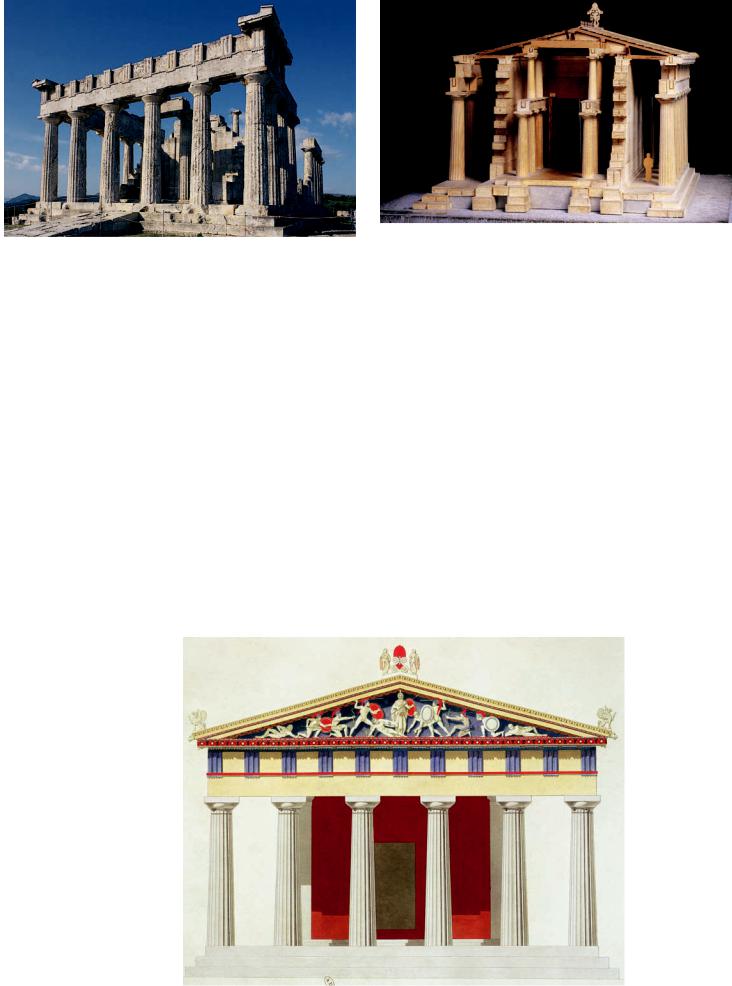
5-25 Temple of Aphaia, Aegina, Greece, ca. 500–490 BCE.
In this refined early-fifth-century BCE Doric design (compare FIG. 5-15), the columns are more slender and widely spaced, and there are only 6 columns on the facade and 12 on the flanks.
5-26 Model of the Temple of Aphaia, Aegina, Greece, ca. 500–490 BCE, showing internal elevation. Glyptothek, Munich.
Later Doric architects also modified the plan of their temples (compare FIG. 5-16). The Aegina temple’s cella has two colonnades of two stories each (originally with a statue of the deity between them).
Aegina and the Transition
to the Classical Period
The years just before and after 500 BCE were also a time of dynamic transition in architecture and architectural sculpture. Some of the changes were evolutionary in nature, others revolutionary. Both kinds are evident in the Temple at Aegina dedicated to Aphaia, a local goddess.
TEMPLE OF APHAIA, AEGINA The temple (FIG. 5-25) sits on a prominent ridge with dramatic views out to the sea. The colonnade is 45 95 feet and consists of 6 Doric columns on the facade and 12 on the flanks. This is a much more compact structure than the impressive but ungainly Archaic Temple of Hera I (FIG. 5-15) at Paestum, even though the ratio of width to length is similar. Doric architects had learned a great deal in the half century that elapsed between construction of the two temples. The columns
of the Aegina temple are more widely spaced and more slender. The capitals create a smooth transition from the vertical shafts below to the horizontal architrave above. Gone are the Archaic flattened echinuses and bulging shafts of the Paestum columns. The Aegina architect also refined the internal elevation (FIG. 5-26) and plan (FIG. 5-27, left). In place of a single row of columns down the center of the cella is a double colonnade—and each row has two stories. This arrangement allowed a statue to be placed on the central axis and also gave worshipers gathered in front of the building an unobstructed view through the pair of columns in the pronaos.
Both pediments featured painted life-size statuary (FIG. 5-27, right) in place of the high reliefs characteristic of Archaic temple pediments. The theme of both statuary groups was the battle of Greeks and Trojans, but the sculptors depicted different episodes. The compositions were nonetheless almost identical, with Athena at the center of the bloody combat. She is larger than all the other figures because she is superhuman, but all the mortal heroes are the
5-27 Plan (left)
and GUILLAUME- ABEL BLOUET’s
1828 restored view of the facade (right) of the Temple of Aphaia, Aegina, Greece, ca. 500–490 BCE.
The restored view suggests how colorful Greek temples were. The designer solved the problem of composing figures in a pediment by using the whole range of body postures from upright to prostrate.
Archaic Per iod |
103 |
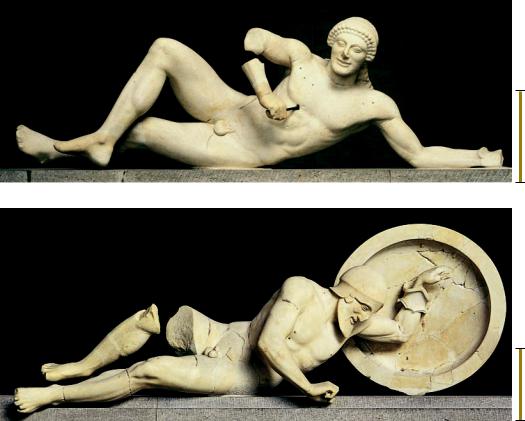
5-28 Dying warrior, from the west pediment of the Temple of Aphaia, Aegina, Greece, ca. 490 BCE. Marble,
5 2 – long. Glyptothek, Munich.
1
2
The statues of the west pediment of the early-fifth-century BCE temple at Aegina exhibit Archaic features. This fallen warrior still has a rigidly frontal torso and an Archaic smile on his face.
1 ft.
5-29 Dying warrior, from the east pediment of the Temple of Aphaia, Aegina, Greece, ca. 480 BCE. Marble, 6 1 long. Glyptothek, Munich.
The eastern dying warrior already belongs to the Classical era. His posture is more natural, and he exhibits a new self-consciousness. Concerned with his own pain, he does not face the viewer.
1 ft.
same size, regardless of the statue’s position in the pediment. Unlike the experimental design at Corfu (FIG. 5-17), the Aegina pediments feature a unified theme and consistent scale. The designer was able to keep the size of the figures constant by using the whole range of body postures from upright (Athena) to leaning, falling, kneeling, and lying (Greeks and Trojans).
The sculptures of the Aegina pediments were probably set in place when the temple was completed around 490 BCE. Many scholars believe the statues at the eastern end were damaged and replaced with a new group a decade or two later, although some think both groups were installed after 480 BCE. Whatever the precise dates of the sculptures, it is very instructive to compare the eastern and western figures. The west pediment’s dying warrior (FIG. 5-28) was still conceived in the Archaic mode. His torso is rigidly frontal, and he looks out directly at the spectator—with his face set in an Archaic smile in spite of the bronze arrow that punctures his chest. He is like a mannequin in a store window whose arms and legs have been arranged by someone else for effective display. There is no sense whatsoever of a thinking and feeling human being.
The comparable figure (FIG. 5-29) in the east pediment is radically different. His posture is more natural and more complex, with the torso placed at an angle to the viewer. (He is on a par with the painted figures of Euphronios, FIG. 5-23.) Moreover, he reacts to his wound as a flesh-and-blood human would. He knows that death is inevitable, but he still struggles to rise once again, using his shield for support. And he does not look out at the spectator. He is concerned with his pain, not with the viewer. No more than a decade separates the two statues, but they belong to different eras. The eastern warrior is not a creation of the Archaic world, when sculptors imposed anatomical patterns (and smiles) on statues from without. This statue belongs to the Classical world, where statues move as humans move and
104 Chapter 5 A N C I E N T G R E E C E
possess the self-consciousness of real men and women. This was a radical change in the conception of what a statue was meant to be. In sculpture, as in painting, the Classical revolution had occurred.
EARLY AND HIGH
CLASSICAL PERIODS
Art historians mark the beginning of the Classical* age from a historical event: the defeat of the Persian invaders of Greece by the allied Hellenic city-states. Shortly after the Persians occupied and sacked Athens in 480 BCE, the Greeks won a decisive naval victory over the Persians at Salamis. It had been a difficult war, and at times it had seemed as though Asia would swallow up Greece, and the Persian king Xerxes (see Chapter 2) would rule over all. When the Persians destroyed the Greek city Miletos in 494 BCE, they killed the male inhabitants and sold the women and children into slavery. The narrow escape of the Greeks from domination by Asian “barbarians” nurtured a sense of Hellenic identity so strong that from then on the history of European civilization would be distinct from the civilization of Asia, even though they continued to interact. Typical of the time were the views of the great dramatist Aeschylus, who celebrated, in his Oresteia trilogy, the triumph of reason and law over barbarous crimes, blood feuds, and mad vengeance. Himself a veteran of the epic battle of Marathon, Aeschylus repudiated in majestic verse all the slavish and inhuman traits of nature that the Greeks at that time of crisis associated with the Persians.
*Note: In Art through the Ages, the adjective “Classical,” with uppercase C, refers specifically to the Classical period of ancient Greece, 480–323 BCE. Lowercase “classical” refers to Greco-Roman antiquity in general, that is, the period treated in Chapters 5, 6, and 7.
